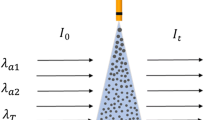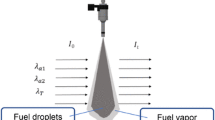Abstract
The evaporation characteristics of multi-component fuel have significant effects on the fuel–air mixing process and subsequent processes, such as ignition, combustion, and harmful pollutants emission formation. When a multi-component fuel is directly injected into the combustion chamber, spatial and temporal equivalence ratio stratification may happen due to the preferential evaporation of components with different volatilities. However, there is a lack of effective optical diagnostics of the spatial stratification in a multi-component fuel spray. In this study, new optical technique based on ultraviolet absorption and visible light schlieren (UAVS) is for the first time proposed to measure the stratification of vapor distributions stratification in a binary-component fuel spray. UAVS technique was applied to investigate the effects of mixing ratios in a binary-component fuel spray (p-xylene and n-hexane) and ambient temperature on the stratification of components with different volatilities. The results denote the UAVS technique as the effective method for the observation of stratification of a multi-component fuel spray. In this study, the stratification phenomenon was the most evident at the ratio of 1:1. At the same time, when the ambient temperature is much higher than the dew point temperature of mixture, the stratification rarely occurs, because of the rapid evaporation thus providing time not enough for preferential evaporation.
Graphic abstract
















Similar content being viewed by others
References
Bardi M, Di Lella A, Bruneaux G (2019) A novel approach for quantitative measurements of preferential evaporation of fuel by means of two-tracer laser induced fluorescence. Fuel 239:521–533
Biswas S, Qiao LA (2017) Comprehensive statistical investigation of schlieren image velocimetry (SIV) using high-velocity helium jet. Exp Fluids 58:18
Chen R, Nishida K, Shi B (2019) Quantitative investigation on the spray mixture formation for ethanol-gasoline blends via UV–Vis dual-wavelength laser absorption scattering (LAS) technique. Fuel 242:425–437
Davy M, Williams P, Han D, Steeper R (2003) Evaporation characteristics of the 3-pentanone–isooctane binary system. Exp Fluids 35(1):92–99
Fansler TD, Parrish SE (2015) Spray measurement technology: a review. Meas Sci Technol 26(1):012002
Itani LM, Bruneaux G, Di Lella A, Schulz C (2015) Two-tracer LIF imaging of preferential evaporation of multi-component gasoline fuel sprays under engine conditions. Proc Combust Inst 35:2915–2922
Kranz P, Kaiser SA (2019) LIF-based imaging of preferential evaporation of a multi-component gasoline surrogate in a direct-injection engine. Proc Combust Inst 37(2):1365–1372
Linne M (2013) Imaging in the optically dense regions of a spray: a review of developing techniques. Prog Energy Combust Sci 39(5):403–440
Ma X, He X, Wang JX, Shuai S (2011) Co-evaporative multi-component fuel design for in-cylinder PLIF measurement and application in gasoline direct injection research. Appl Energy 88(8):2617–2627
Makino A, Law CK (1988) On the controlling parameter in the gasification behavior of multicomponent droplets. Combust Flame 73(3):331–336
Marcia LH (2007) NIST Standard Reference Database 4: NIST thermophysical properties ofhydrocarbon mixtures database (SUPERTRAPP). https://www.nist.gov/publications/nist-4-thermophysical-properties-hydrocarbon-mixtures-database-version-30
Meijer M, Somers B, Johnson J, Naber J, Lee SY, Malbec LMC, Bazyn T (2012) Engine combustion network (ECN): characterization and comparison of boundary conditions for different combustion vessels. At Sprays 22(9):777–806
Otsu N (1979) A threshold selection method from gray-level histograms. IEEE Trans Syst Man Cybern 9(1):62–66
Pastor J, Payri R, Garcia-Oliver J, Nerva J (2012) Schlieren measurements of the ECN-spray A penetration under inert and reacting conditions, SAE Technical Paper 2012-01-0456.
Pickett LM, Kook S, Williams TC (2009) Visualization of diesel spray penetration, cool-flame, ignition, high-temperature combustion, and soot formation using high-speed imaging. SAE Tech Paper 2(1):439–459
Qi W, Zhang Y (2018) A three-color absorption/scattering imaging technique for simultaneous measurements on distributions of temperature and fuel concentration in a spray. Exp Fluids 59:70
Qi W, Zhang Y (2019) Quantitative measurement of binary-component fuel vapor distributions via laser absorption and scattering imaging. Appl Phys B 125(7):127
Qi W, Zhou Y, Zhang Y (2020) Laser-based measurements and analyses on cycle-to-cycle variations of mixture formation in binary-component fuel sprays. Exp Fluids 61:87
Settles GS (2012) Schlieren and shadowgraph techniques: visualizing phenomena in transparent media. Springer Science & Business Media, Berlin
Settles GS, Hargather MJ (2017) A review of recent developments in schlieren and shadowgraph techniques. Meas Sci Technol 28(4):042001
Stevens RE, Ma H, Stone CR, Walmsley HL, Cracknell R (2007) On planar laser-induced fluorescence with multi-component fuel and tracer design for quantitative determination of fuel concentration in internal combustion engines. Proc Inst Mech Eng Part D 221(6):713–724
Swindal JC, Dragonetti DP, Hahn RT, Furman PA, Acker WP (1995) In-cylinder charge homogeneity during cold-start studied with fluorescent tracers simulating different fuel distillation temperatures. SAE Tech Paper 1995-01-06
Westlye FR, Penney K, Ivarsson A, Pickett LM, Manin J, Skeen SA (2017) Diffuse back-illumination setup for high temporally resolved extinction imaging. Appl Opt 56:5028–5038
Williams B, Ewart P, Stone R, Ma H, Walmsley H, Cracknell R, Wallace S (2008) Multi-component quantitative PLIF: robust engineering measurements of cyclic variation in a firing spray-guided gasoline direct injection engine. SAE Tech Paper 2008-01-1073
Yoon JK, Myong KJ, Senda J, Fujimoto H (2009) Analysis of spatial vapor-phase distribution using the LIF method on multi-component fuel. J Mech Sci Technol 23(9):2565–2573
Zhang Z (2000) A flexible new technique for camera calibration. IEEE Trans Pattern Anal 22:1330–1334
Zhang Y, Nishida K (2007) Vapor distribution measurement of higher and lower volatile components in an evaporating fuel spray via laser absorption scattering (LAS) technique. Combust Sci Technol 179(5):863–881
Zhang R, Sick V (2007) Multi-component fuel imaging in a spray-guided spark-ignition direct-injection engine. SAE Tech Paper 2007-01-1826
Zhang Y, Zhang G, Xu M et al (2013) Droplet temperature measurement based on 2-color laser-induced exciplex fluorescence. Exp Fluids 54:1583
Zigan L, Schmitz I, Fliigel A, Knorsch T, Wensing M, Leipertz A (2010) Effect of fuel properties on spray breakup and evaporation studied for a multi-hole direct injection spark ignition injector. Energy Fuels 24:4341–4350
Acknowledgements
The research was sponsored by National Natural Science Foundation of China (No. 91741130) and Intergovernmental International Cooperation in Science and Technology Innovation (No. 2016YFE0127500).
Author information
Authors and Affiliations
Corresponding author
Additional information
Publisher's Note
Springer Nature remains neutral with regard to jurisdictional claims in published maps and institutional affiliations.
Rights and permissions
About this article
Cite this article
Qi, W., Zhou, Y. & Zhang, Y. An optical diagnostic technique based on ultraviolet absorption and schlieren for components stratification in a binary-component fuel–air mixture. Exp Fluids 61, 230 (2020). https://doi.org/10.1007/s00348-020-03063-w
Received:
Revised:
Accepted:
Published:
DOI: https://doi.org/10.1007/s00348-020-03063-w




